
PUMPA - SMART LEARNING
எங்கள் ஆசிரியர்களுடன் 1-ஆன்-1 ஆலோசனை நேரத்தைப் பெறுங்கள். டாப்பர் ஆவதற்கு நாங்கள் பயிற்சி அளிப்போம்
Book Free DemoFinding the square roots of numbers with a large number of digits by factorisation becomes time-consuming and lengthy. In such cases, we can use the long division method. Let us see this method in a detailed manner.
Steps to find the square root using the long division method:
Step 1: Starting with the digit in the unit's position, group the digits in pairs. Each pair and the
remaining digit (if any) is called a period. Starting from the right of the given number, place a bar over each pair of digits. If the number of digits is odd, the extreme left digit may not have a bar sign above it. For example, \(2 \ \overline{34}\).
remaining digit (if any) is called a period. Starting from the right of the given number, place a bar over each pair of digits. If the number of digits is odd, the extreme left digit may not have a bar sign above it. For example, \(2 \ \overline{34}\).
Step 2: Recognise the largest number whose square is equal to or slightly less than the first period. This number should be used as both a divisor and a quotient.
Step 3: Subtract the product of the divisor and the quotient from the first period and bring down the next period to the right of the remainder. This becomes the new dividend.
Step 4: The new divisor is created by multiplying the quotient by two and adding a suitable digit to it, which is also the quotient's next digit. The product of the new divisor and this digit is equal to or less than the new dividend.
Step 5: Repeat steps \(2\), \(3\) and \(4\) till all the periods have been taken up. The final obtained quotient is the square root of the given number.
Example:
Find the square root of \(65536\).
Solution:
Step 1: Group the digits in pairs and place a bar over each pair of digits. The given number digits is odd, so the extreme left digit does not have a bar sign above it. That is, \(6 \ \ \overline{55} \ \ \overline{36}\).
Step 2: The extreme left number here is \(6\). The largest number whose square is equal to or slightly less than \(6\) is \(2\). This number should be used as both a divisor and a quotient.

Step 3: Subtract the product of the divisor and the quotient from the first period and bring down the next period to the right of the remainder. That is \(255\). This becomes the new dividend.
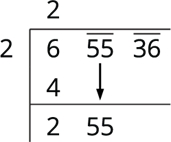
Step 4: Find the new divisor, multiply the earlier quotient \((2)\) by \(2\) (always) and write it, leaving a blank space next to it.
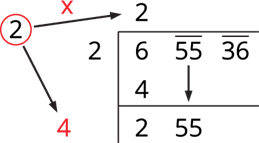
Step 5: The new divisor is \(5\), followed by a digit. We should choose this digit next to \(4\) such that the new quotient multiplied by the new divisor will be less than or equal to \(255\).
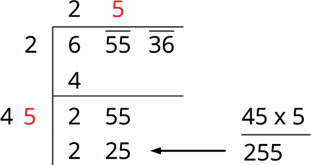
Now, subtract \(225\) from \(255\) and bring down the next period to the right of the remainder. That is \(3036\). This becomes the new dividend.
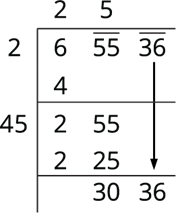
To find the new divisor, multiply the earlier quotient \((25)\) by \(2\) (always) and write it, leaving a blank space next.
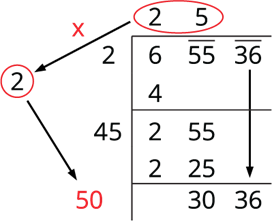
The new divisor is \(50\), followed by a digit. The required digit here has to be \(6\). We put \(6\) in the blank space and write \(3036\) below \(3036\) and subtract to get the remainder \(0\).
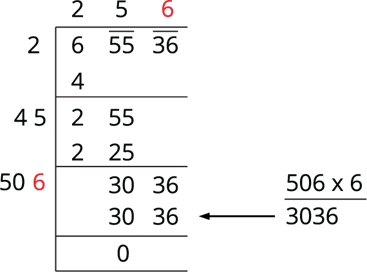
Therefore, \(\sqrt{65536}\) \(=\) \(256\).